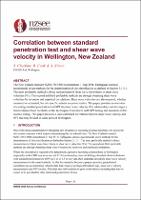| dc.contributor.author | Cherfane, Stephanie | |
| dc.contributor.author | Cook, Rowan | |
| dc.contributor.author | Riman, Ayoub | |
| dc.date.accessioned | 2020-06-18T13:41:55Z | |
| dc.date.available | 2020-06-18T13:41:55Z | |
| dc.date.issued | 2020-04-22 | |
| dc.identifier.uri | https://repo.nzsee.org.nz/xmlui/handle/nzsee/1697 | |
| dc.description.abstract | The New Zealand standard NZS1170.5:2004 (amendment 1; Sep 2016; Earthquake actions) recommends seven methods for the determination of site classification as defined in Section 3.1.3.1. The most preferable method is direct measurement of shear wave travel times or shear wave velocities (Vs). The second and third preferable methods are through obtaining shear wave velocities by inversion and empirical correlations. Shear wave velocities are also required, whether measured or estimated, for site specific seismic response studies. This paper provides an overview of existing standard penetration test (SPT) to shear wave velocity (Vs) relationships and leverages a limited dataset from boreholes in the Wellington Central area with SPT testing and downhole (DH) seismic testing. This paper provides a local calibrated correlation between shear wave velocity and SPT that may be used in some parts of Wellington. | |
| dc.language.iso | en | |
| dc.publisher | New Zealand Society for Earthquake Engineering | |
| dc.relation.ispartofseries | 2020;34 | |
| dc.subject | Geotechnical Engineering Innovations | |
| dc.title | Correlation between standard penetration test and shear-wave velocity in Wellington, New Zealand | |
| dc.type | Article | |

